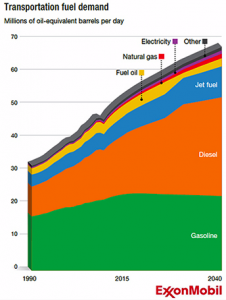 The recent projections for future energy consumption from Exxon Mobil’s report, “Outlook for Energy,” and the EIA’s “Annual Energy Outlook, 2013” essentially said the same thing concerning the potential for natural gas and its derivative methanol: Natural gas use now is only about 1 percent of the total fuel used in vehicles, and by 2040, it will only rise to 4 percent.
The recent projections for future energy consumption from Exxon Mobil’s report, “Outlook for Energy,” and the EIA’s “Annual Energy Outlook, 2013” essentially said the same thing concerning the potential for natural gas and its derivative methanol: Natural gas use now is only about 1 percent of the total fuel used in vehicles, and by 2040, it will only rise to 4 percent.
This increase will take place in the trucking sector and liquefied natural gas (LNG). Owners of automobiles will not rush to natural gas, because of a lack of pumping stations and the low density of natural gas. Adam Sieminski, EIA administrator, said, “what really holds natural gas back is the infrastructure to refuel and how much energy you can put into a vehicle is limited.”
However, both reports appear to underestimate the future demand for natural gas and methanol. For example, Exxon Mobil’s study does not reveal its assumptions concerning the price of gasoline versus natural gas. Both Exxon Mobil and EIA suggest that gasoline prices will peak in the next decade and begin to decline because of energy efficiency, CAFE standards and the increased use of alternative fuels, particularly powered by electricity. Neither explores in depth the impact of price differentials on efficiency. Yes, gasoline is denser and gets more miles per gallon gasoline equivalent (MPGe). But technology has reduced the differential and the price of gasoline remains comparatively high, which permits differences concerning density to be minimized considerably. Therefore, natural gas and its derivative methanol are likely to remain cheaper than gasoline and attract many cost conscious consumers.
Furthermore, neither report discusses the impact on the demand for natural gas and methanol should Congress decide to develop policies and legislation to curb GHG emissions from cars and trucks. Such actions would favor natural gas and methanol-fueled automobiles over gasoline-powered ones.
What’s your take on these projections for natural gas demand? What barriers are preventing the ratio of natural gas in the transportation fuel mix from increasing?
Find the rest of Marshall Kaplan’s original post on his blog, Over A Barrel, at the Fuel Freedom Foundation.
Our Energy Policy did a great job editing down a longer piece on Fuel Freedom’s blog. It is my fault that on reading a couplve of key sentences were left… Read more »
Assuming a 50% reduction of pollution from any gaseous or liquid fuels because of new technology at little additional cost, and assuming peak oil pricing dynamics that will increase the… Read more »